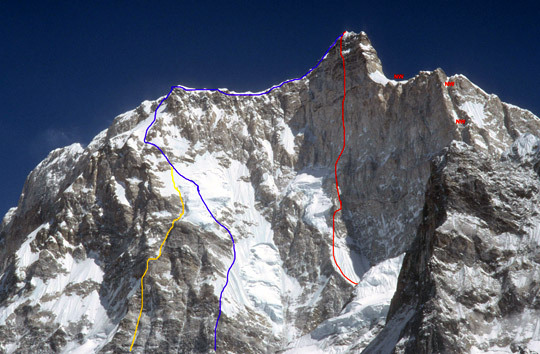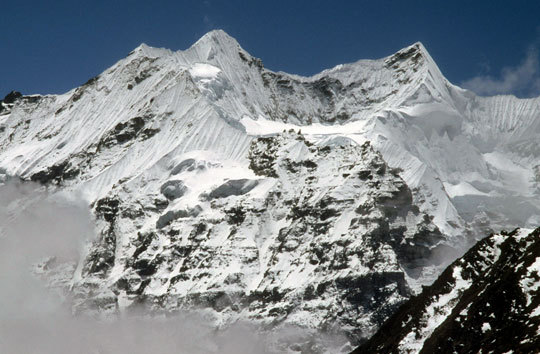
The famous northwest aspect of Jannu (7710m) in the Kumbhakarna Himal of East Nepal. The yellow line is the incomplete route soloed to 6900m by Jordi Tozas in autumn 2007. The blue line is the Original 1976 Japanese route on the northwest face, a route that has been repeated twice. The red line is the 2004 Russian Direct on the true north face, while “NW” designates the northwest ridge. At the time of writing, with the Russian pair still on the mountain, the exact line of their autumn 2007 is not clear, though it is suspected they climbed the top tower above the shoulder on the right flank. [Photo] Lindsay Griffin
Russian climbers have come in for some criticism recently after their completely sieged ascent of K2’s West Face. Reports just in suggest the balance has been addressed with Valeri Babanov’s and Sergey Kofanov’s eight-day, alpine-style ascent of the northwest ridge of Jannu (7710m).
The ridge is a well-known line that was first seriously attempted in the autumn of 1994. A strong French team of Xavier Cret, Robin Molinatti, Pierre Rizzardo and Paul Robach gained the plateau below the north face and fixed rope on the technically demanding ice wall below the ca. 6300m col that separates Sobithongie (6669m) from the start of the northwest ridge. Some sections here were continuous 80 degrees. The team continued up the ridge above, only slightly less technical, until 6900 meters, where the combination of difficulty, high winds and cold forced them to abandon the mountain.
In 1998 an equally powerful French team comprising Jean-Marc Genevois, Emmanuel Guy, Manu Pellissier and Patrick Pessi retreated ca. 100 meters short of the col, finding the route technically very difficult and objectively dangerous. They had two near misses when almost hit by serac falls on the wall below the col.
On October 6 the Russian pair acclimatized by making the second official ascent of Merra (6334m), a multi-summited complex in the Anidesh Himal north of the Kumbhakarna Glacier. The first known ascent of the highest summit had been made on October 18, 2006, by Claus Ostergaard from Denmark, who climbed the upper section solo.
Having previously inspected the line of the northwest ridge from the plateau, Babanov and Kofanov set off on October 14 from base camp, leaving Babanov’s wife Olga manning (womaning?) the radio. They camped that night at 5500m. Next day they reached 5930m on the steep snow/ice face leading to the col, and the following evening reached the col itself at ca. 6300m. Continuing up the narrow ridge on the 17th, they passed previous high points and on the 19th were camped on the shoulder at 7400m. The two Russians left next day with minimal gear, taking a tent but no sleeping bags. That evening they erected their tent at 7600m and sat through what must have been a pretty miserable night. On the 21st at 9.30 a.m. they stepped onto the summit and by evening had descended to the shoulder. The weather at times had been truly fierce, with low temperatures and very strong winds. Even Olga at base camp sometimes found it difficult to understand the climbers radio speak due to the strength of the wind. At the time of writing Babanov and Kofanov are still descending the mountain, but have obviously achieved something special by completing a coveted line in what appears to be excellent style.
But the Russians were not the only climbers on Jannu this season. At the end of September, the accomplished Catalan mountaineer, Jordi Tozas, made a discreet attempt on a new route up the left side of the northwest face. Overcoming transport difficulties from Kathmandu due to Maoist activities and, subsequently, a difficult approach march via Ghunsa due to a vigorous tail-end to the monsoon, Tozas and a trekking companion arrived on the Kumbhakarna Glacier below the spectacular north side of the mountain. The Catalan spent a week acclimatizing to ca. 6000m in the surrounding terrain, and then very early one morning set off from his base camp for the face, heading for the steep rib that defines the left side. Starting well left of the Original 1976 Japanese route and a little left of the fall-line of the giant seracs that characterize the lower section of this route, Tozas climbed snow and ice couloirs to a rib that gave access to the objectively threatened terrain at the left edge of the large serac barrier. From here he bypassed the seracs on the left and continued on steep snow slopes to join the Japanese Route. At 6900m, after almost 1900m of new climbing, reported to be equivalent to Alpine ED, an increasing danger of avalanche due to the great depth of snow, plus his own tiredness, forced him to give up. He made a delicate descent of the Japanese route and returned safely to base camp.

The beautiful Merra peaks in the Anidesh Himal seen from the northwest. The left peak is the main summit (6334m) and received its second known ascent by Babanov and Kofanov on October 6. [Photo] Lindsay Griffin